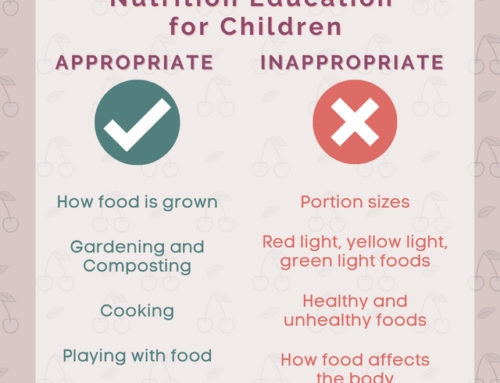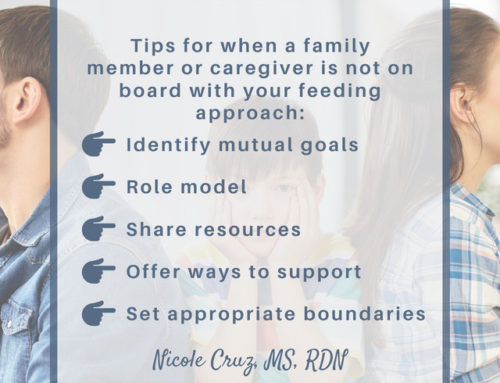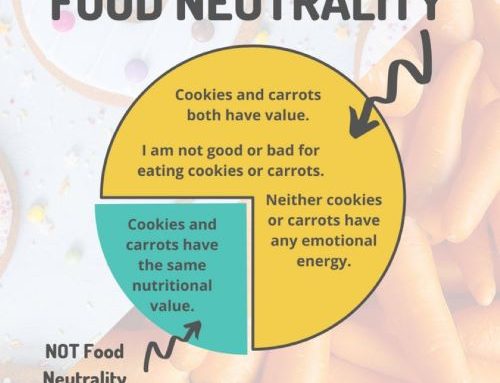Lately I’ve been hearing a lot more about concerns that following the Division of Responsibility (DOR) just doesn’t seem like it can work for certain families or situations… And I get it! Sometimes following Ellyn Satter’s DOR can be confusing.
By now you’ve likely heard of this feeding philosophy, but I’ll give you the short and sweet version. In its most basic terms: Parents decide what, when, and where food is offered. Children decide if and what to eat from the food provided.
While it sounds simple in theory, it can be complex in practice. We’re human. We have our own food beliefs and preferences, personalities, schedules and circumstances. And we have children with different personalities and preferences as well.
So I absolutely understand why it might feel like it can’t work for you, but I also believe that the basic foundation and principles of it can work for EVERYONE. The way it actually looks in each person’s home though, that’s a different story.
For instance, if you have a child that continues to reject everything you serve, you may need to get them more involved in the entire process. They may need to be a part of meal planning, grocery shopping, looking up recipes, and cooking. Or perhaps they need to be given 2-3 choices at every meal or come up with a list of snacks they would like to have.
Another child might not care and just eat whatever you give them.
If you have a child who doesn’t like to eat, you might find putting a little food on their plate encourages them to try a food, even though you’re not telling them to eat. Another child might shut down and refuse to eat if you put food on their plate because it feels like too much pressure.
There are different ways we can address children’s personalities and different situations, but the same principles can still apply!
Now for the answers to your most common questions and roadblocks…
Does it mean that my child can just eat whatever is in the house?
As the parent you are choosing both what to bring into the home and what is being provided at each eating time. This does not mean that you can’t give your child one or two choices, do you want peanut butter and jelly or turkey sandwich? Or do you want chips or pretzels?
What if my child asks for something that’s not being offered?
Be thoughtful and considerate and check in with your intentions. For instance, if they ask for something but you’ve already made a meal or snack, you might say, “We’ll have that later, I’ve already made ‘xyz’.” Or if they ask for something but you’re saving it for a different meal, you can also let them know you’re saving it for lunch the next day, or whenever.
On the flip side, if you haven’t chosen a snack yet, you might say “Sure. Put that on the counter and I’ll grab some other food to go with it.” And then put the whole snack out together. Or maybe you put out dinner and they ask for something and you realize, you really didn’t put out a satisfying dinner, you might say, “Yeah, let’s put some ‘x’ out for everyone.”
However, if you’re saying “no” trying to control the size of their body or only have them eat “healthy,” you might need to reconsider those intentions. Or if you’re constantly saying yes just to avoid a tantrum or meltdown.
Do I have to be strict with meal times?
You do not have to be strict with meal times, but you do need to be sure you are offering regular opportunities to eat. Children generally need to eat every 2-3 hours. Children also tend to do well with some structure, or at least knowing what to expect. In other words, I would try to keep a regular rhythm, so you’re offering breakfast, snack, lunch, snack, dinner, snack. Or whatever works best for your schedule and family. For instance, my children are typically up early, so I offer a morning snack before I’m ready to make breakfast, and they count on that. They don’t always eat it, but they know it will be available and they’re welcome to have it.
What if they’re hungry between a meal or snack?
One of the main purposes of offering set meals and snacks (as opposed to letting children eat whenever they want) is to set them up to be hungry for meal times and to be exposed to a variety of foods.
If you find that your child never asks for snacks other than when you normally offer food, but appears to be extremely hungry one day, you might offer a small snack to hold them over before the next eating time.
If they are never eating what you provide, but are constantly wanting to choose their own snacks between meals, then you will want to remind them food will be available soon. Also be sure that you are always offering something you know they like at every meal and snack and you are including some of their favorite snacks at those times as well.
If you notice your child is eating at the regular intervals but always hungry, or never eating at certain times, then this is a pattern. You will want to reassess your meal and snack times and what you offer.
What if they only want to eat one food at a meal or snack?
Let them. Your job is to provide the food. Their job is to decide what to eat from the foods you put out.
What if they just keep eating?
Also, let them. Hunger is not something that anyone can gauge but your child. You will want to be sure you offering regular meals and snacks so they are not getting overly hungry and then appear to be eating more. Children best regulate their own portions without interference. And restricting portions often leads to sneaking or hiding food and eating more than would have normally been consumed.
The DOR philosophy feels a little strict, do I have to follow it perfectly?
It can feel strict to some families and personality types. You might find that you offer snack periods throughout the day instead of set snacks and that works well for your family. Or when you offer desserts, you allow them to have as much as they want instead of just one portion.
However, I strongly suggest you follow the very basic principles or jobs. You are responsible for the what, when, and where. Your child is responsible for how much to eat, if anything.

Depending on the situation, when your child asks you for food, there are times when an appropriate response is “yes” and other’s when it’s “later” or “at dinner,” etc. Sometimes an extra snack makes sense because there’s a longer period between meals or you didn’t provide enough substance. Sometimes it’s best to hold the boundary because they refused to eat the snack you provided and it’s now 20 minutes until dinner.
It’s not always clear cut, but children do tend to respond better to some structure and boundaries without being overly controlled or rigid. One of the most important pieces of all, is to remember we want food to be positive and joyful!
Thank you for joining me and letting me be a part of your journey in creating joyful eating for your family. I look forward to connecting with you soon!








Leave A Comment